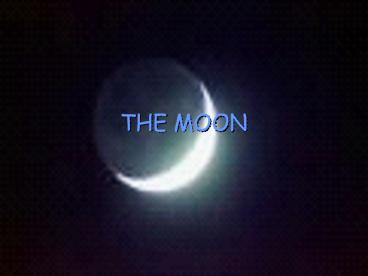THE MOON PowerPoint PPT Presentation
1 / 23
Title: THE MOON
1
THE MOON
2
THE SURFACE OF THE MOON
- It has no atmosphere, so a record of all the
impacts has been preserved - We know the age of the moon, so by counting the
of impact craters they can find the rate of
cratering. - Knowing the rate of cratering, scientists can use
the of craters on any body to estimate how old
the bodys surface is.
3
LUNAR ORIGINS
- 3 popular explanations for the moons origins
- 1. The moon was a separate body captured by
Earths gravity. - 2. Moon formed at the same time from the same
materials as the Earth - 3. The newly formed Earth was spinning so fast
that a piece flew off became the moon
4
LUNAR ORIGINS
- The composition of the Moon was similar to the
Earths mantle. - Found through rock samples
- Current Theory
- A large object collided with Earth, while the
Earth was still forming. - This was so violent that a chunk of the earths
mantle was blasted into orbit around the earth to
form the Moon
5
PHASES OF THE MOON
- Within a month it changes from a fully lit circle
to a thin crescent back to a circle. - This is a result from its changing position
relative to the earth and the Sun - As the moon revolves around the Earth, the amount
of sunlight on the side of the moon that faces
the Earth changes
6
PHASES OF THE MOON
- New Moon
- Waxing Crescent
- First Quarter
- Waxing Gibbous
- Full Moon
- Waning Gibbous
- Last Quarter
- Waning Crescent
7
NEW MOON
- Moon is between the Sun and Earth and is not
visible in the sky
8
WAXING CRESCENT
- Lighted area appears to be growing larger
- Right side of the Moon as seen from Earth is
lighted.
9
FIRST QUARTER
- ¼ OF THE WAY AROUND THE EARTH. HALF OF THE MOON
IS LIGHTED
10
WAXING GIBBOUS
- Lighted areas of the moon continues to grow.
- Right side of the Moon as seen from Earth is
lighted.
11
FULL MOON
- Entire lighted side of the Moon is visible from
Earth
12
WANING GIBBOUS
- Lighted area of the Moon appears to be getting
smaller. - Left side of the Moon as seen from Earth is
lighted.
13
LAST QUARTER
- ¾ of the way around the Earth.
- Half of the moon is lighted.
14
WANING CRESCENT
- Lighted area continues to grow smaller.
- Left side of the Moon as seen from Earth is
lighted.
15
Waxing and Waning
- WAXING
- The sunlit fraction we can see is getting LARGER
- Waning-
- The sunlit fraction we can see is getting SMALLER
- The moons period of rotation is the same its
period of revolution, so on Earth you always see
the same side of the moon
16
How the Moon affects the Tides
17
ECLIPSES
- Eclipse
- When the shadow of one celestial body falls on
another
18
SOLAR ECLIPSE
- When the moon comes between the Earth and the Sun
and the shadow of the moon falls on part of the
Earth - Annular eclipse (partial)
- Moon is farther from the Earth
- The disk of the moon does not completely cover
the disk of the Sun - Penumbra lighter outer part of a shadow
- Total Solar Eclipse
- The disk of the moon completely covers the disk
of the sun - Umbra Darker inner part of a shadow
19
Umbra Penumbra
20
LUNAR ECLIPSE
- Happens when the Earth comes between the sun and
the moon and the shadow of Earth falls on the
moon. - During a lunar eclipse the Earths atmosphere
acts like a lens and bends sunlight into the
Earths shadow. - Most of the light you see during a lunar eclipse
is red.
21
The Tilted Orbit Of The Moon
- The Moon is tilted about 5 degrees relative to
the orbit of the Earth around the Sun. - This is enough to place the moon out of the
Earths shadow for most full moons and the Earth
out of the moons shadow for most new moons
22
How the tilt affects the seasons
23
Seasons
- http//www.teachersdomain.org/ext/ess05_int_season
sgame/index.html

